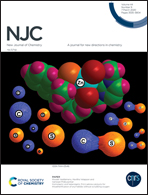Optimized synthesis of thermally stable axially modified pyrazine-acene nanoribbon with gelation properties†
Abstract
In this paper, we explored comprehensive synthetic approaches to axially substituted N-heteroacene based nanoribbon with 11 linearly annulated rings. Although synthetically tedious, we found that a stepwise cyclization between α-diketone and o-aromatic diamine to grow nanoribbon is more efficient than simultaneous dicylization in one step using 3,6-disubstituted-1,2,4,5-tetraaminobenzene. In addition, for the axial modification, pre-modification of a building block was superior to post-modification of preformed nanoribbon. The nanoribbon was characterized with UV-Vis spectroscopy, CV, DSC, and TGA. The nanoribbon showed a relatively stabilized ELUMO of −3.74 eV due to the electron-deficient nature of the core and reduced Egap of 1.55 eV as a result of intramolecular charge transfer between the core and axial thiophene. The electronic properties were also investigated with theoretical calculations at B3LYP/6-31G* level of theory/basis set. Particular attention was paid to the distribution of frontier molecular orbitals as these correlated with the measured electronic properties. The title nanoribbon exhibited remarkable thermal stability with a 424 °C decomposition temperature at 5% weight loss. The axially substituted nanoribbon showed excellent one-dimensional fibrillation properties via organogelation. The nanoribbon gelled hydrocarbon solvents and select halogenated solvents with the lowest critical gelation concentration of 1.2 mM in hexadecane. FE-SEM confirmed the existence of endless flexible one-dimensional fibers with a thickness of ca. 200 nm. Despite the large π-core, the axial functionalization imparted not only processability but also self-assembly ability while maintaining excellent thermal stability. These properties would be useful in future optoelectronic applications.



 Please wait while we load your content...
Please wait while we load your content...